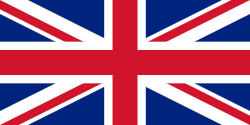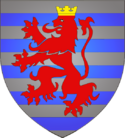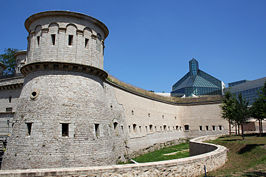Luxembourg (city)
|
||||||||||||||||||||||||||||||||
|
||||||||||||||||||||||||||||||||
The city of Luxembourg (Luxembourgish: Lëtzebuerg, German: Luxemburg), also known as Luxembourg City (Luxembourgish: Stad Lëtzebuerg, French: Ville de Luxembourg, German: Luxemburg Stadt), is a commune with city status, and the capital of the Grand Duchy of Luxembourg. It is located at the confluence of the Alzette and Pétrusse rivers in southern Luxembourg and contains the historic Luxembourg Castle, established by the Franks in the Early Middle Ages, about which the area grew up.
Contents |
As of 2007, the commune of Luxembourg City has a population of 83,820 , which is almost three times the population of the second most populous commune. The city's metropolitan population, including that of surrounding communes of Hesperange, Sandweiler, Strassen, and Walferdange, is 103,973. Luxembourg City lies at the heart of Western Europe, situated 188 km (117 miles) from Brussels, 289 km (179 miles) from Paris, 190 km (118 miles) from Cologne.[1]
Luxembourg City is one of the wealthiest cities in the world, having developed into a banking and administrative centre. Luxembourg is a seat of several institutions of the European Union, including the European Court of Justice, the European Court of Auditors, and the European Investment Bank.
History
In the Roman era, a fortified tower guarded the crossing of two Roman roads that met at the site of Luxembourg city. Through an exchange treaty with the abbey of Saint Maximin in Trier in 963, Siegfried I of the Ardennes, a close relative of King Louis II of France and Emperor Otto the Great, acquired the feudal lands of Luxembourg. Siegfried built his castle, named Lucilinburhuc ("small castle"), on the Bock Fiels ("rock"), mentioned for the first time in the aforementioned exchange treaty.
In 987 Egbert, Archbishop of Trier blessed five altars in the Church of the Redemption (today St. Michael's Church). At a Roman road intersection near the church, a marketplace appeared around which the city developed.
The city, for reasons of its location and natural geography, has through history been a place of strategic military significance. The first fortifications were built as early as the 10th century. By the end of the 12th century, as the city expanded westward around the new St. Nicholas Church (today the cathedral of Notre Dame), new walls were built that included an area of 50,000 m².
In about 1340, under the reign of John the Blind, new fortifications were built that stood until 1867.
In 1443, the Burgundians under Philip the Good conquered Luxembourg. Luxembourg became part of the Burgundian, and later Spanish and Austrian empires (See Spanish Netherlands and Spanish road) and under those Habsburg administrations Luxembourg Castle was repeatedly strengthened so that by the 16th century, Luxembourg itself was one of the strongest fortifications in Europe. Subsequently, the Burgundians, the Spanish, the French, the Spanish again, the Austrians, the French again, and the Prussians conquered Luxembourg.
In the 17th century, the first casemates were built; initially, Spain built 23 km of tunnels, starting in 1644.[2] These were then enlarged under French rule by Marshal Vauban, and augmented again under Austrian rule in the 1730s and 1740s.

During the French Revolutionary Wars, the city was occupied by France twice: once, briefly, in 1792–3, and, later, after a seven-month siege.[3] Luxembourg held out for so long under the French siege that French politician and military engineer Lazare Carnot called Luxembourg "the best [fortress] in the world, except Gibraltar", giving rise to the city's nickname: the 'Gibraltar of the North'.[4]
Nonetheless, the Austrian garrison eventually surrendered, and, as a consequence, Luxembourg was annexed into the French Republic as part of the département of Forêts, with Luxembourg City as its préfecture. Under the 1815 Treaty of Paris, which ended the Napoleonic Wars, Luxembourg City was placed under Prussian military control as a part of the German Confederation, although sovereignty passed to the House of Orange-Nassau, in personal union with the United Kingdom of the Netherlands.
After the Luxembourg Crisis, the 1867 Treaty of London required Luxembourg to dismantle the fortifications in Luxembourg City. Their demolition took sixteen years, cost 1.5 m gold francs, and required the destruction of over 24 km (15 miles) of underground defences and 40,000 m² (10 acres) of casemates, batteries, barracks, etc.[5] Furthermore, the Prussian garrison was to be withdrawn.[6]

When, in 1890, Grand Duke William III died without any male heirs, the Grand Duchy passed out of Dutch hands, and into an independent line under Grand Duke Adolphe. Thus, Luxembourg, which had hitherto been independent in theory only, became a truly independent country, and Luxembourg City regained some of the importance that it had lost in 1867 by becoming the capital of a fully independent state.
Despite Luxembourg's best efforts to remain neutral in the First World War, it was occupied by Germany on 2 August 1914. On 30 August, Helmuth von Moltke moved his headquarters to Luxembourg City, closer to his armies in France in preparation for a swift victory. However, the victory never came, and Luxembourg would play host to the German high command for another four years. At the end of the occupation, Luxembourg City was the scene of an attempted communist revolution; on 9 November 1918, communists declared a socialist republic, but it lasted only a few hours.[7]
In 1921, the city limits were greatly expanded. The communes of Eich, Hamm, Hollerich, and Rollingergrund were annexed into Luxembourg City, making the city the largest commune in the country (a position that it would hold until 1978).

In 1940, Germany occupied Luxembourg again. The Nazis were not prepared to allow Luxembourgers self-government, and gradually integrated Luxembourg into the Third Reich until it annexed the Grand Duchy, on 30 August 1942. Luxembourg City was liberated on 10 September 1944.[8]
After the war, Luxembourg ended its neutrality, and became a founding member of several inter-governmental and supra-governmental institutions. In 1952, the city became the headquarters of the High Authority of the European Coal and Steel Community. In 1967, the High Authority was merged with the commissions of the other European institutions; although Luxembourg City would no longer be the seat of the ECSC, it would play host to some part-sessions of the European Parliament until 1981.[9] Luxembourg remains the seat of the European Parliament's secretariat, as well as the European Court of Justice, the European Court of Auditors, and the European Investment Bank. Several departments of the European Commission are also based in Luxembourg.
Geography
Topography



Luxembourg City lies on the southern part of the Luxembourg plateau, a large Early Jurassic sandstone formation that forms the heart of the Gutland, a low-lying and flat area that covers the southern two-thirds of the country.
The city centre occupies a picturesque site on a salient, perched high atop precipitous cliffs that drop into the narrow valleys of the Alzette and Pétrusse rivers, which find their confluence at Luxembourg City. The 70 m- (230 ft) deep gorges cut by the rivers are spanned by many bridges and viaducts, including the Adolphe Bridge, the Grand Duchess Charlotte Bridge, and the Passerelle. Although Luxembourg City is not particularly large, its layout is complex, as the city is set on several levels, straddling hills and dropping into the two gorges.
The commune of Luxembourg City covers a total area of over 51 km², or 2% of the Grand Duchy's total area. This makes the city the fourth-largest commune in Luxembourg, and by far the largest urban area. Luxembourg City is not particularly densely-populated, at under 1,500 people per km²; large areas of Luxembourg City are maintained as parks, forested areas, or sites of important heritage (particularly the UNESCO sites), while there are also large tracts of farmland that lie within the city limits.
Quarters of Luxembourg City
Luxembourg City is subdivided into twenty-four quarters, which cover the commune in its entirety. The quarters generally correspond to the major neighbourhoods and suburbs of Luxembourg City, although a few of the historic districts, such as Bonnevoie, are divided between two quarters.
Climate
Luxembourg City has a mild continental climate, marked by moderately high precipitation.
| Jan | Feb | Mar | Apr | May | Jun | Jul | Aug | Sep | Oct | Nov | Dec | |
|---|---|---|---|---|---|---|---|---|---|---|---|---|
| Mean daily maximum temperature (°C) | 3 | 4 | 10 | 14 | 18 | 21 | 23 | 22 | 19 | 13 | 7 | 4 |
| Mean daily minimum temperature (°C) | -1 | -1 | 1 | 4 | 8 | 11 | 13 | 12 | 10 | 6 | 3 | 0 |
| Mean total rainfall (mm) | 61 | 65 | 42 | 47 | 64 | 64 | 60 | 84 | 72 | 53 | 67 | 81 |
| Mean number of rain days (0.25mm+) | 20 | 16 | 14 | 13 | 15 | 14 | 14 | 15 | 16 | 15 | 19 | 20 |
| Average sunshine (hours per day) | 1 | 2 | 5 | 6 | 6 | 6 | 6 | 6 | 5 | 3 | 1 | 1 |
| Source: BBC Weather | ||||||||||||
Government
Local government

Under the Luxembourgian constitution, local government is centred on the city's communal council. Consisting of twenty-seven members (fixed since 1964), each elected every six years on the second Sunday of October and taking office on 1 January of the next year,[10] the council is the largest of all communal councils in Luxembourg. The city is nowadays considered a stronghold of the Democratic Party (DP),[11] which is the third-largest party nationally. Currently, the Democratic Party is the largest party on the council, with eleven councillors.[12]
The city's administration is headed by the mayor, who is the leader of the largest party on the communal council. As a result of the DP's control of the communal council, the mayor has been the DP's Paul Helminger since 18 August 1999.[11] The mayor leads the cabinet, the collège échevinal, in which the DP forms a coalition with The Greens.[13] Unlike other cities in Luxembourg, which are limited to four échevins at most, Luxembourg is given special dispensation to have six échevins on its collège échevinal.[14]
National government
Luxembourg City is the Seat for the Luxembourg Government. The Grand Ducal Family of Luxembourg also lives there.

European institutions
Luxembourg City is the seat of several institutions of the European Union, including the European Court of Justice, the European Commission, the secretariat of the European Parliament, the European Court of Auditors and the European Investment Bank. The majority of these institutions are located in the Kirchberg quarter, in the northeast of the city.
Places of interest

Places of interest include the neogothic Cathedral of Notre Dame, the fortifications, the Grand Ducal Palace, the Gëlle Fra war memorial, the casemates, the Neumünster Abbey, the Place d'Armes, the Adolphe Bridge and the city hall. The city is the home of the University of Luxembourg and Radio Luxembourg.
The Second World War Luxembourg American Cemetery and Memorial is located within the city limits of Luxembourg at Hamm. This cemetery is the final resting place of 5,076 American military dead, including General Patton. There is also a memorial to 371 Americans whose remains were never recovered or identified. Other places of interests include:
|
|
|
Twin towns
 Camden, United Kingdom[15]
Camden, United Kingdom[15] Wythenshawe United Kingdom
Wythenshawe United Kingdom Metz, France
Metz, France
See also
- List of mayors of Luxembourg City
- Eurovision Song Contest 1962, held at the Villa Louvigny
- Eurovision Song Contest 1966, held at the Villa Louvigny
- Eurovision Song Contest 1973, held at the Nouveau Théâtre Municipal
- Eurovision Song Contest 1984, held in the Nouveau Théâtre Municipal
Footnotes
- ↑ "Great Circle Distances between Cities". United States Department of Agriculture. Archived from the original on 2005-03-26. Retrieved on 2006-07-23.
- ↑ "The Fortress". Luxembourg City Tourism Office. Retrieved on 2006-07-23.
- ↑ Kreins (2003), p. 64
- ↑ Kreins (2003), p. 64
- ↑ "World Heritage List - Luxembourg" (PDF). UNESCO (1 October 1993). Retrieved on 2006-07-19.
- ↑ (French) Treaty of London, 1867, Article IV. GWPDA. Retrieved on 2006-07-19.
- ↑ Luxembourg country profile. WorldStatesman.org. Retrieved on 2006-07-23.
- ↑ Thewes (2003), p. 121
- ↑ "Alcide De Gasperi Building". Centre Virtuel de la Connaissance sur l’Europe (16 June 2006). Retrieved on 2006-07-23.
- ↑ (French) "Attributions du conseil communal". Ville de Luxembourg. Retrieved on 2007-09-21.
- ↑ 11.0 11.1 (French) Hansen, Josée (8 October 1999). "Cliff-hanger", Lëtzebuerger Land. Retrieved on 2007-09-21.
- ↑ (French) "Composition du conseil communal". Ville de Luxembourg. Retrieved on 2007-09-21.
- ↑ (French) "Composition du collège échevinal". Ville de Luxembourg. Retrieved on 2007-09-21.
- ↑ (French) "Organisation des communes - Textes Organiques". Code administratif Luxembourgeois. Service central de législation (2007). Retrieved on 2007-09-21.
- ↑ "Twin Towns in the UK". Dorset Twinning Association (11 May 2007). Retrieved on 2007-09-21.
References
- (French) Kreins, Jean-Marie (2003). Histoire du Luxembourg (3rd edition ed.). Paris: Presses Universitaires de France. ISBN 978-21-3053-852-3.
- (French) Thewes, Guy (July 2003) (PDF). Les gouvernements du Grand-Duché de Luxembourg depuis 1848 (Édition limitée ed.). Luxembourg City: Service Information et Presse. ISBN 2-87999-118-8. http://www.gouvernement.lu/publications/download/gouvernements_1848_2.pdf. Retrieved on 2006-07-06.
External links
- Commune of Luxembourg official website
- Luxembourg City Tourism
- Museum of the city of Luxembourg website
- HoloGuides - photos, events and news
- Luxembourg (city) travel guide from Wikitravel
- Luxembourg (city) Photo Gallery
|
|||||
|
|||||
|
|||||

